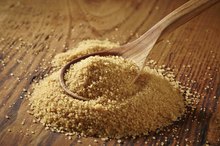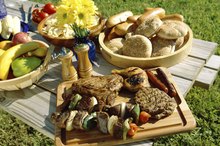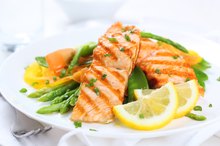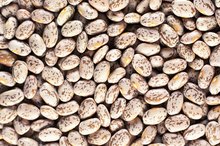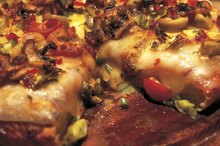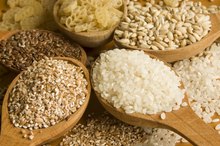Foods Not to Eat With Parkinson's Disease
Parkinson's is a progressive disease that causes trembling, rigidity, slowed movement and poor coordination in an estimated 1 million people in the United States, according to the Parkinson's Disease Foundation 13. Although no known cure exists, medications, psychotherapy and dietary changes may help manage your symptoms and lower your risk for potential complications. A healthy diet improves your energy levels and overall quality of life. For best results, seek specified guidance from your doctor or dietitian.
If you are experiencing serious medical symptoms, seek emergency treatment immediately.
Enriched Flour
The process used to produce enriched flour strips the original grain of vitamins, minerals and fiber. Increased fiber intake may help alleviate constipation, which often accompanies Parkinson's disease, according to the University of Maryland Medical Center 2. To increase the fiber content of your diet, replace enriched breads, pasta, cereals and snack foods with 100 percent whole grain equivalents. Nutritious whole grains include:
- barley
- oats
- brown rice
- wild rice
- bulgur
- whole wheat
- air-popped popcorn
- The process used to produce enriched flour strips the original grain of vitamins, minerals and fiber.
Excessive Protein-Rich Foods
Bad Foods for Low Thyroid
Learn More
Protein provides amino acids that promote lean tissue growth and repair and proper brain function. Although protein plays an important role in most diets, eating more than modest amounts interfere with the Parkinson's disease medication levodopa in some people, according to dietitian affiliated with the Parkinson's Disease Foundation, Karol Traviss 13. Foods particularly high in protein include meat, fish and dairy products, such as milk and cottage cheese. Because dairy products and fish are valuable sources of calcium and vitamin D, which are important for preventing osteoporosis, incorporate modest amounts into your meals routinely. When consuming meat, Traviss recommends limiting your portion to roughly the size of a deck of cards. Limiting protein-rich foods early in the day in particular may also help prevent medication-related problems.
- Protein provides amino acids that promote lean tissue growth and repair and proper brain function.
- Because dairy products and fish are valuable sources of calcium and vitamin D, which are important for preventing osteoporosis, incorporate modest amounts into your meals routinely.
Fava Beans
Fava beans are a nutritious legume variety that benefits some people with Parkinson's disease and causes problems for others 3. Because they contain a natural form of levodopa, eating fava beans, particularly in large quantities, may lead to an overdose. The UMMC recommends discussing fava beans with your doctor before adding them to your diet.
Added Sugars
Diet Plan for Compulsive Eating
Learn More
Added sugars contribute calories and sweet flavor but few nutrients. A sugar-rich diet leaves little room for beneficial foods, such as fruits, vegetables and whole grains, and leads to weight gain when indulged in excess. Maintaining a healthy body weight and eating primarily healthy foods are important for Parkinson's disease patients 3. To avoid excessive sugar intake, keep your kitchen well-stocked with healthy fare and limit processed snack foods, such as candy, cookies and soft drinks. Other common sources of added sugars include:
- pancake syrup
- jellies
- jam
- pastries
- frozen desserts
- pie
- Added sugars contribute calories and sweet flavor but few nutrients.
- A sugar-rich diet leaves little room for beneficial foods, such as fruits, vegetables and whole grains, and leads to weight gain when indulged in excess.
Related Articles
References
- Letanneux, A, Danna, J, Velay, JL, Viallet, F, Pinto, S. From micrographia to Parkinson’s disease dysgraphia. Mov Disord. 2014;29:1467-1475. doi:10.1002/mds.25990
- Ylikoski A, Martikainen K, Sieminski M, Partinen M. Sleeping difficulties and health-related quality of life in Parkinson's disease. Acta Neurol Scand. 2017;135(4):459-468. doi:10.1111/ane.12620
- Diederich NJ, Fénelon G, Stebbins G, Goetz CG. Hallucinations in Parkinson disease. Nat Rev Neurol. 2009;5(6):331-42. doi:10.1038/nrneurol.2009.62
- Ozturk EA, Gundogdu I, Kocer B, Comoglu S, Cakci A. Chronic pain in Parkinson's disease: Frequency, characteristics, independent factors, and relationship with health-related quality of life. Journal of Back and Musculoskeletal Rehabilitation. 2016; 30(1):101-108. doi:10.3233/BMR-160720
- Pagonabarraga J, Kulisevsky J. Apathy in Parkinson's disease. Int Rev Neurobiol. 2017;133:657-678. doi:10.1016/bs.irn.2017.05.025
- Schapira AHV, Chaudhuri KR, Jenner P. Non-motor features of Parkinson disease. Nat Rev Neurosci. 2017;18(8):509. doi:10.1038/nrn.2017.62
Writer Bio
August McLaughlin is a certified nutritionist and health writer with more than nine years of professional experience. Her work has been featured in various magazines such as "Healthy Aging," "CitySmart," "IAmThatGirl" and "ULM." She holds specializations in eating disorders, healthy weight management and sports nutrition. She is currently completing her second cookbook and Weight Limit—a series of body image/nutrition-related PSAs.
